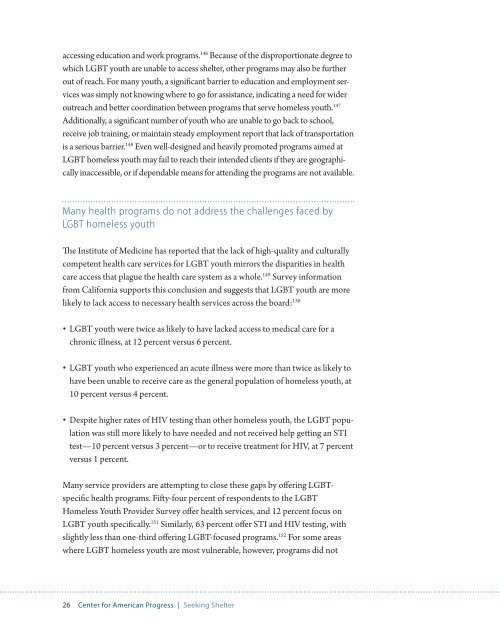LGBTHomelessYouth
LGBTHomelessYouth
LGBTHomelessYouth
You also want an ePaper? Increase the reach of your titles
YUMPU automatically turns print PDFs into web optimized ePapers that Google loves.
accessing education and work programs. 146 Because of the disproportionate degree to<br />
which LGBT youth are unable to access shelter, other programs may also be further<br />
out of reach. For many youth, a significant barrier to education and employment services<br />
was simply not knowing where to go for assistance, indicating a need for wider<br />
outreach and better coordination between programs that serve homeless youth. 147<br />
Additionally, a significant number of youth who are unable to go back to school,<br />
receive job training, or maintain steady employment report that lack of transportation<br />
is a serious barrier. 148 Even well-designed and heavily promoted programs aimed at<br />
LGBT homeless youth may fail to reach their intended clients if they are geographically<br />
inaccessible, or if dependable means for attending the programs are not available.<br />
Many health programs do not address the challenges faced by<br />
LGBT homeless youth<br />
The Institute of Medicine has reported that the lack of high-quality and culturally<br />
competent health care services for LGBT youth mirrors the disparities in health<br />
care access that plague the health care system as a whole. 149 Survey information<br />
from California supports this conclusion and suggests that LGBT youth are more<br />
likely to lack access to necessary health services across the board: 150<br />
• LGBT youth were twice as likely to have lacked access to medical care for a<br />
chronic illness, at 12 percent versus 6 percent.<br />
• LGBT youth who experienced an acute illness were more than twice as likely to<br />
have been unable to receive care as the general population of homeless youth, at<br />
10 percent versus 4 percent.<br />
• Despite higher rates of HIV testing than other homeless youth, the LGBT population<br />
was still more likely to have needed and not received help getting an STI<br />
test—10 percent versus 3 percent—or to receive treatment for HIV, at 7 percent<br />
versus 1 percent.<br />
Many service providers are attempting to close these gaps by offering LGBTspecific<br />
health programs. Fifty-four percent of respondents to the LGBT<br />
Homeless Youth Provider Survey offer health services, and 12 percent focus on<br />
LGBT youth specifically. 151 Similarly, 63 percent offer STI and HIV testing, with<br />
slightly less than one-third offering LGBT-focused programs. 152 For some areas<br />
where LGBT homeless youth are most vulnerable, however, programs did not<br />
26 Center for American Progress | Seeking Shelter


